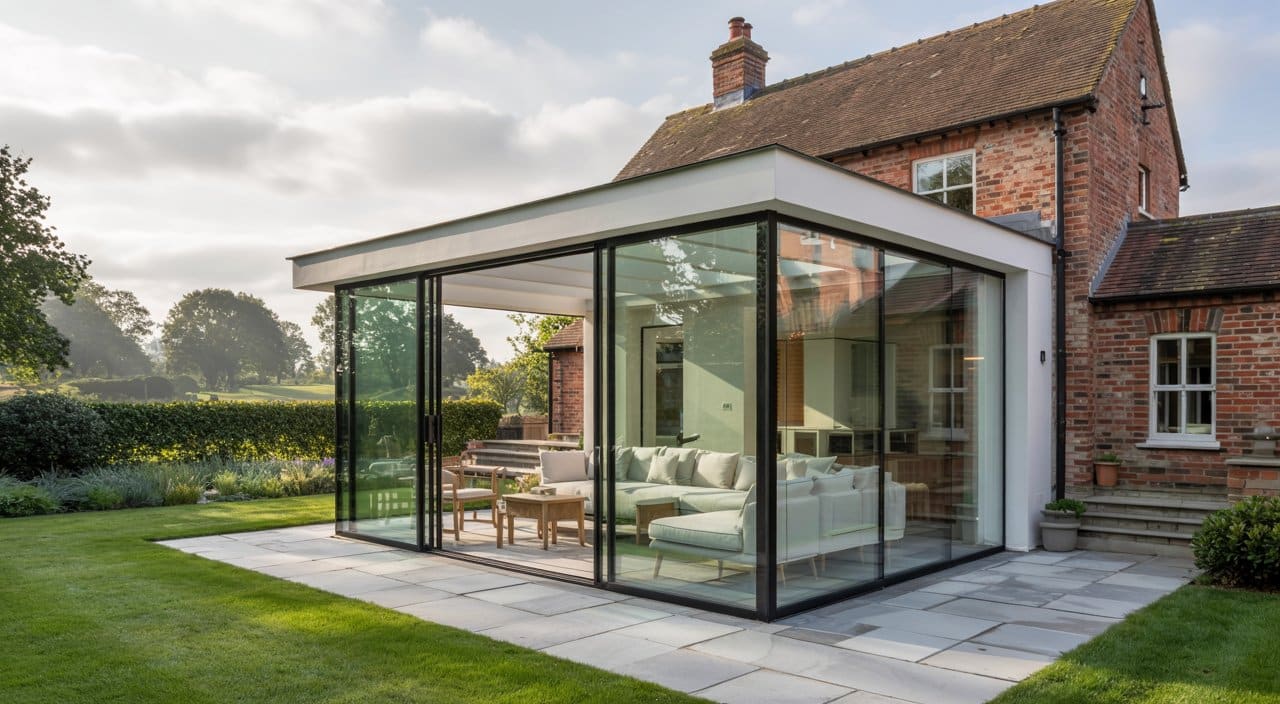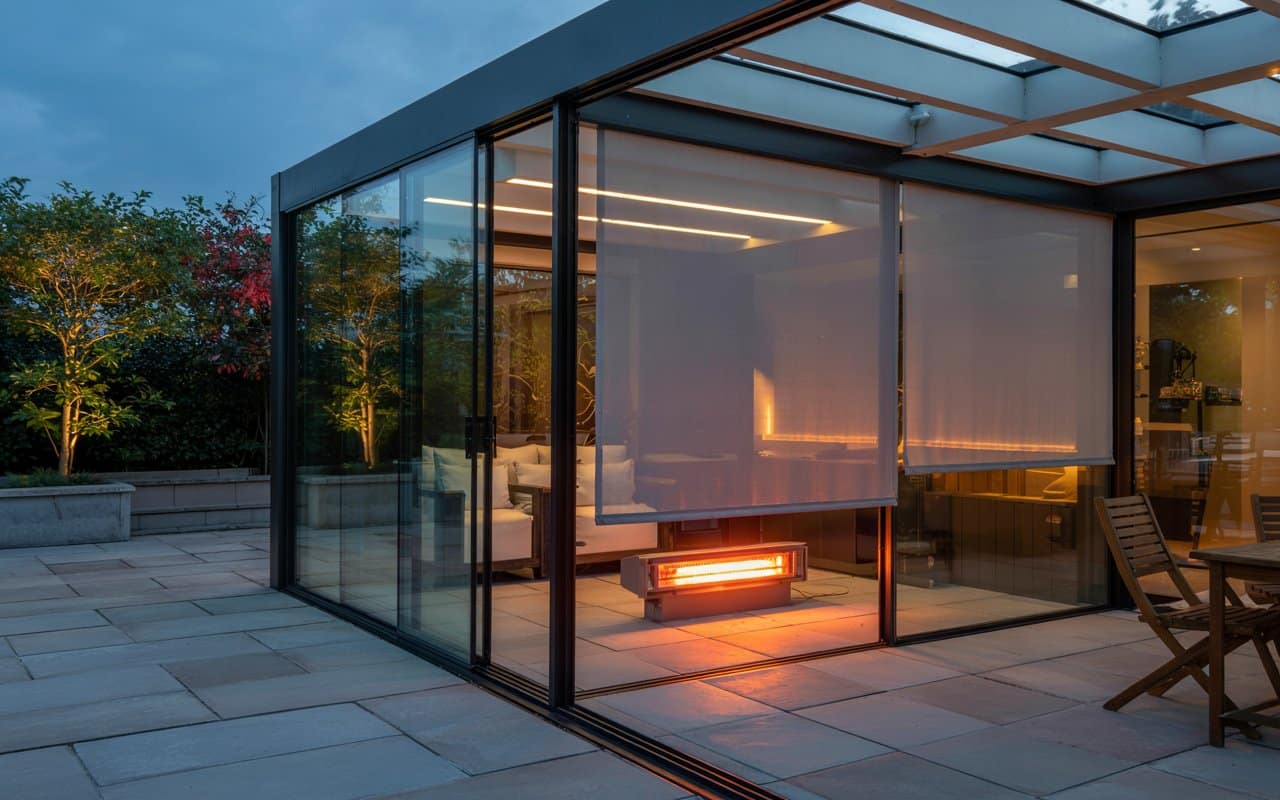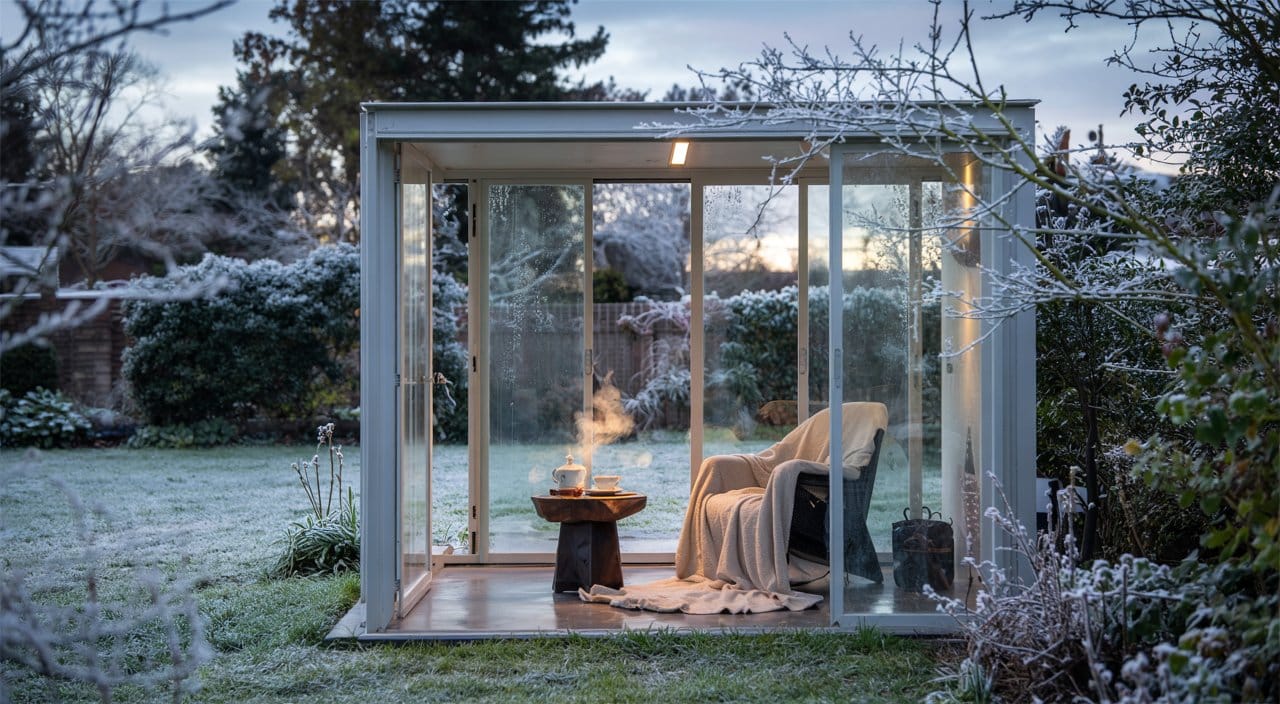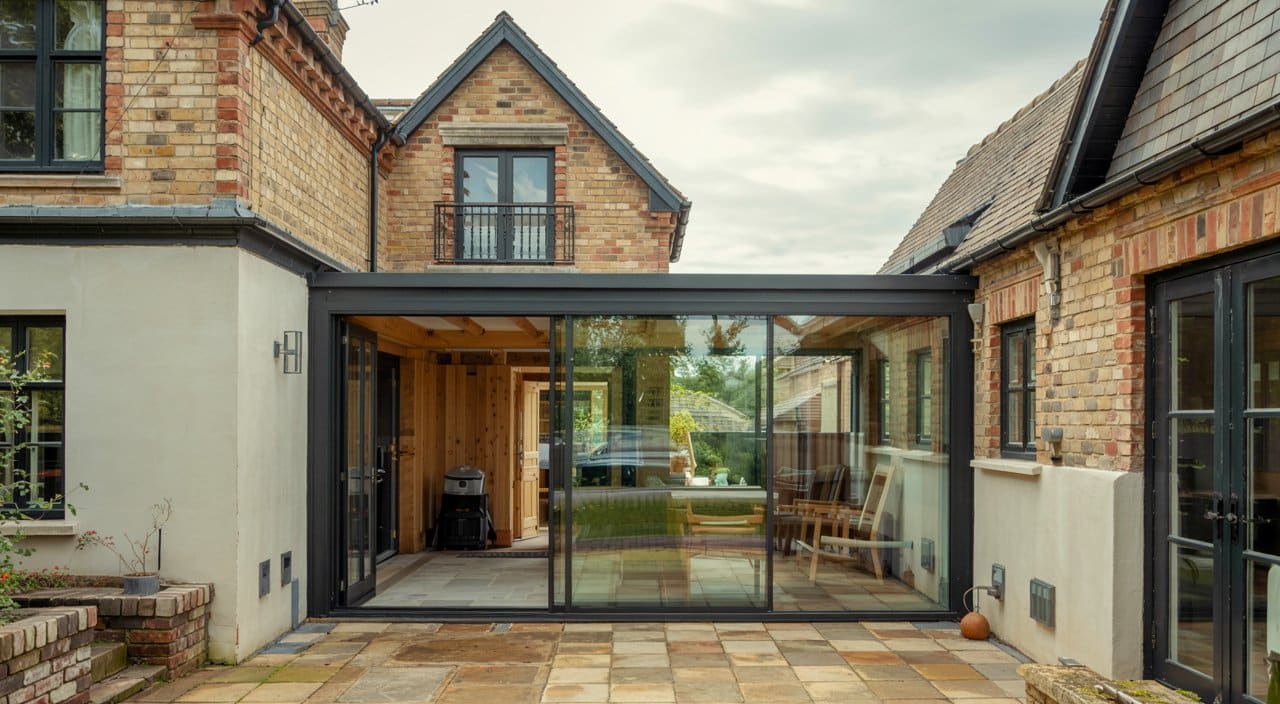What Sets Frameless Glassrooms Apart in Modern Outdoor Living?
Beyond the Limits of the Old Patio
A garden can feel like a distant memory by late autumn. If you’ve stood by the window, wishing your favourite green corner was more than weather’s afterthought, you know the dead zone syndrome. Your eyes meet condensation on old polycarbonate, or a plastic awning sags under drizzle. Your outdoor life retreats indoors—for months. Most high-spec homeowners and designers have tried “solutions” that promise to fix this seasonal problem, only to realise that most structures, even bold-looking extensions or off-the-shelf glass roofs, end up looking bolted on. Their presence is always an architectural compromise.
Seamless Architecture, Perpetual Connection
Frameless glassrooms break with this tired compromise entirely. Our approach—rooted in German-engineered, fully glazed panels—removes barriers at every level. Unframed, uninterrupted glass walls slide aside to dissolve boundaries, merging house and horizon. The eye follows a single line from polished interior floor to the furthest garden edge. There is no awkward threshold, no intrusive hardware, no feeling that space is “added on.” An authentic glassroom is experienced daily, not just admired.
“What used to be wasted patio now frames every memory—our garden is never out of reach.”
Emotional Outcome: A Life More Open
This leap in design leaves a mark on your habits. Meals extend into evenings; napping with rain pattering overhead becomes ritual. The boundary between inside and out softens, and your living space inherits the moods of passing clouds, moonlit evenings, and golden frosts—all without the cost of discomfort. A glassroom, when truly frameless and efficiently installed, is not simply architecture. It’s an invitation to use, enjoy, and command every season, every day.
How Does Advanced Glassroom Engineering Deliver All-Weather Confidence?
Weather-Proof by Specification, Not Hope
Doubt about durability is warranted; experiences of glassrooms gone wrong are easy to find. Rooms that rattle in the wind, seal poorly, or need constant cleaning betray homeowner investment and erode trust in the category. Many rival systems push past marketing spin but lack true environmental resilience. Our promise begins with data, not words.
Technical Mastery for British (and Nordic) Weather
Each glassroom is defined by EN 12150-certified laminated safety glass, engineered to resist dramatic wind speeds (Beaufort 11+) and withstand the 500kg/m² snow loads typical of harsh European winters. Every hardware joint, post, and trip-free floor track is tested against deformation, channel leaks, and hardware freeze. UV inhibitors in glass and coated frames prevent ageing, yellowing, or microcracking—maintaining full clarity and colour even after many seasons.
“That first winter brought storms and sleet, but our glassroom was silent and bright—it changed how we see the seasons.”
Maintenance and Peace of Mind, Built-In
Design is nothing if it can’t deliver confidence over time. Drainage channels hidden within glass-to-frame junctions guide rainwater away before it stains; soft-close tracks keep sliding doors functioning year after year without wrestling with stuck panels. The sound-damping properties of triple-glazed roofs allow you to relax while the wind howls outside. Cleaning is drastically reduced compared to older systems; a soft cloth or gentle squeegee returns glass to perfect transparency.
For every installation, our team validates comfort metrics—surface temperature, ambient moisture, airflow. In-house benchmarks and homeowner testimonials confirm that comfort and ease-outlast seasonal shifts, turning “garden rooms for summer only” into garden rooms for all life. Request load data, specification sheets, or installation snapshots: proof is always a scroll away.
Which Features and Customisation Paths Define Excellence?
Modular Possibility, Not Overwhelm
Choice should empower, not paralyse. Whether you’re a premium homeowner, landscape architect, or venue operator, the expansion of options—glass types, privacy screens, climate features—can quickly spiral into decision fatigue. That’s precisely why our process deconstructs every feature into a benefit, not a technical jargon pile.
Key Features at the Forefront
- Tempered and Laminated Glass: Each panel maximises light and sound control while resisting fracture or clouding.
- Multi-Track Sliding Walls: Open your room fully, vent discreetly, or secure against a squall—total spatial control awaits.
- RAL Colour Palette: Over 200 hues to match or accent your façade, from muted greys and whites to standout modern tones.
- Security Integration: Hidden locks, anti-pry hardware, and laminated joints ensure privacy and safety without visual bulk.
- Climate & Mood Control: Integrated, low-profile blinds, under-glass shading, and ValancePlus options that respond to real weather, not just a timer.
- Lighting Mastery: From subtle LED edge glows to fully dimmable scene lighting, night becomes yours.
Visual Table: Feature Comparison
| Feature | Our Glassrooms | Traditional Conservatory | Generic Summer House |
|---|---|---|---|
| True Frameless Glass | Yes | No | No |
| Custom RAL Frame Finish | Yes | Rarely | Rarely |
| Structural Snow/Wind Proof | Beaufort 11+, 500kg/m² | Often Unrated | No |
| Maintenance-Reducing Drainage | Yes | Limited | No |
| Security Hardware | Invisible, Standard | Yes (Visible) | No |
| Lighting/Climate Response | Integrated | Add-on | No |
“We thought accessory upgrades would mean visible clutter, but every option blends in seamlessly—it just feels like our home.”
Counselling the Decision-Maker
Our specification process uses your property’s context—aspect, local weather, architectural language—to help clarify the right set of features and finish. We treat design, not just engineering, as the heart of system performance. This means that whether your goal is minimal luxury for a Chelsea patio or technical resilience for rural weather, every option aligns to make “excellence” not a selling point, but an expectation.
Why Is Frameless Engineering a Lifestyle and Value Revolution?
Mood, Light, Life: A Recalibration of Home
For high-value buyers—and for those who see their home as a reflection of storey, not status—space is more than square footage. It’s about light, mood, privacy, the rituals that shape days and seasons. Poor extensions or “solution” rooms too often become “dead zones,” stealing both sunlight and joy. Our glassrooms are engineered to reverse this architectural stagnation.
Continuous Light and Emotional Elevation
The science is simple: light boosts wellbeing and raises moods, winter or summer. When a frameless system brings unfiltered daylight deep into the property, breakfast feels like being outdoors regardless of forecast. Evening gatherings don’t move inside with the first gust of rain. Instead, your day flows without interruption, and the garden backdrop remains ever-present.
Mini-Narratives, Maximum Impact
- Wellness Retreat: Morning yoga with dawn’s rays, surrounded by roses or autumn gold.
- Garden Office: Productive hours in natural light, sheltered from glare or noise, with a garden view.
- Hospitality/Entertaining: Even on blustery Saturdays, friends linger, drawn by the clarity and comfort of your glassroom—a beacon on the block.
“What we gained was more than a room—it made our routines better, our gatherings longer, and our house feel alive.”
The Subtle Dividend: Value
Estate agents, surveyors, and homeowners consistently report uplift: properties with functional, all-season, architecturally-matched glassrooms draw faster offers and higher prices. The value is as much daily as financial—measured in time used, comfort enjoyed, and moods uplifted, year after year.
How Does Flexible Design Bring Glassrooms to Any Plot or Structure?
Refusing to Settle: Custom Fit for Complex Sites
An uncooperative layout—the garden slopes, the access is narrow, the wind is brutal—stops many projects before they start. Too often, modular is misunderstood as “one size fits most,” a recipe for awkward gaps or visible mismatches. Our methodology is the opposite: modular engineering enables custom fit wildcards that generic builds miss.
Adaptive Engineering for Every Environment
Our glassrooms can be phased, expanded, or retrofitted as your needs and space change.
- Post positions angle to context, supporting odd-angled patios or extended terraces.
- Side and front panels scale up or down as family size or site accessibility shifts.
- Frame anchoring adapts to brick, block, render, or timber frame—no matter your build.
- Lighting, heating, or shading instals can be planned up front or added years later.
- Colour and material choices cross reference local planning requirements, ensuring compliance and aesthetic fit.
Table: Design Flexibility by Challenge
| Challenge | Flexible Solution | Long-Term Benefit |
|---|---|---|
| Sloped Patio | Adjusted post heights | Seamless sightlines |
| Shaded Aspect | Ultra-clarity roof glass | Maximum light transfer |
| Urban South Facing | Solar-reject finishes | Heat + glare control |
| Strict Planning | Discreet colours, documentation | Smoother council approval |
“We believed our sloped, shaded patio made a glassroom impossible. Now it’s the best part of the property.”
When you trust our process, your outdoor transformation ignores the limits others accept. Each design begins with site, storey, and future needs—then builds outward, covering complexity, protection, and taste.
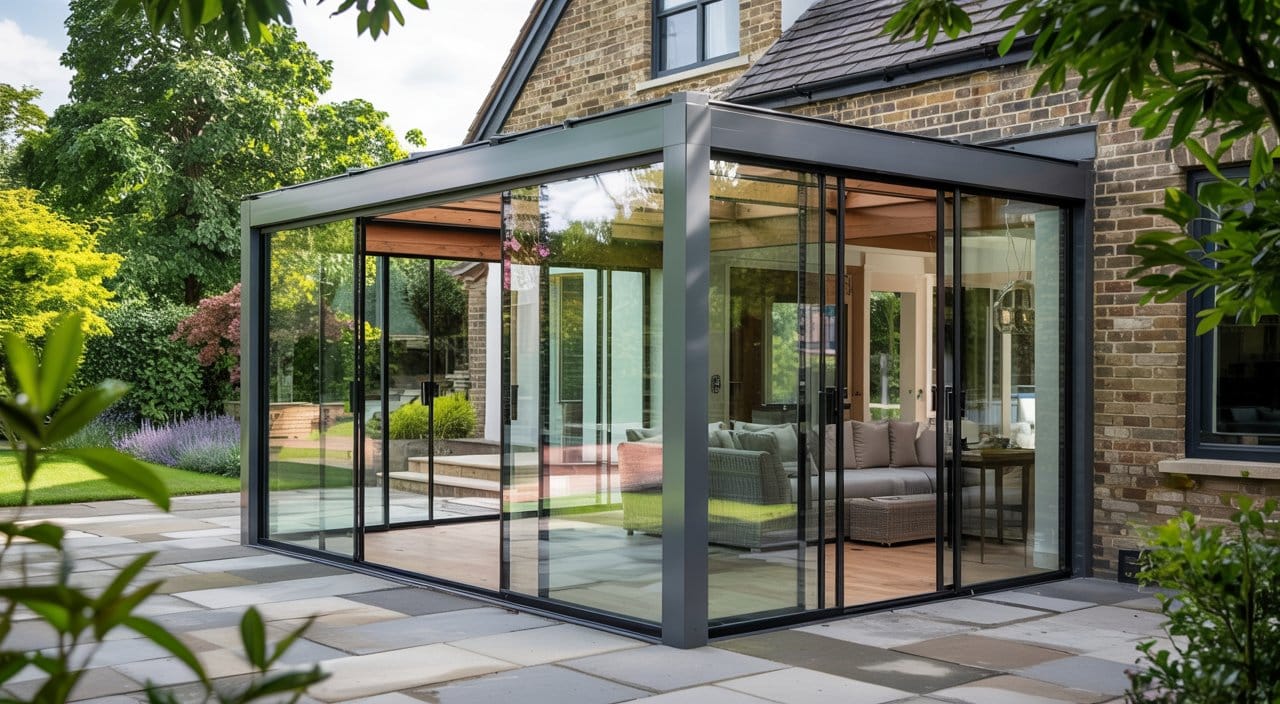
When Should You Invest for Maximum Comfort and Long-Term Value?
Timing Is Opportunity
For families and property owners, the best moment is usually signalled by accumulated friction: patios that only see sun from May to September, living zones that, though designed for “all year,” are abandoned at the first breeze or drizzle, and plans for events that hinge on “if the weather holds.” Comfort lost is time—not easily replaced. For venues, revenue gaps from rained-out bookings transform mild dissatisfaction into real financial pain, every quarter.
Architecting for Long-Term ROI
A glassroom is less a seasonal gift than a platform for daily renewal. We analyse your calendar, property cycle, and future goals to align project phasing to optimal value points—spring completion for new family routines, or autumn instal to capture the full indoor-outdoor sweep by next summer.
Key Value Touchpoints:
- Resale: UK property studies confirm 8–15% higher asking price for homes with architecturally uniform year-round outdoor structures.
- Energy Savings: Passive gain cuts winter heating costs while shading options protect from summer surges.
- Lifestyle Expansion: Hosting, working, celebrating—formerly weather-dependent joy becomes reliable, frictionless routine.
- Market Differentiation: In high-demand areas, time-on-market plunges for homes with all-season garden integration.
The Reluctant Wait
“We kept postponing—then saw the neighbours gain a new room. That pushed us. Now, every month ‘waiting on weather’ just feels absurd.”
By the time most owners instal, the decision feels overdue. The fastest route to value is through planning that links comfort, aesthetics, and market insight to your actual living patterns. Our team anchors that process, fusing analysis with creative discipline—the way great spaces, not just pretty rooms, are made.
Where Are Glassrooms Most Advantageous for Homes and Commercial Properties?
Landscape, Building, and Business Integration
Location informs every design. Urban homes on tight plots unlock luxury by pushing out beyond old walls—vertical gardens and treetop views become possible in a way brickwork never allowed. Rural or suburban homes take panoramic slices of garden and culture, extending living well beyond predictable seasons. Each property, each design brief, asks a different question—the ideal glassroom must answer all without repeating generic answers.
Transformational Results, Site by Site
- Urban Apartment: Rooftop—expanded light, year-round skyline access, minimal dead space.
- Family Home: Garden rooms bring unused corners to life; children and guests become new regulars.
- Hospitality Venue: Covered seating means bookings don’t waver with forecast; per-cover income climbs, and “always open” advertising becomes true.
- Health & Spa: Therapy, wellness, and beauty venues gain clarity, privacy, and tranquillity.
“Adding a glassroom didn’t just solve our weather headaches—it made the patio the place everyone wanted to be.”
No matter the application, the smart use of light, shelter, and seamless material blending is never a one-off. Every installation joins use-cases: event hosting, work-from-home sanctuaries, afternoon reading nooks, or cityscape dining. The property and lived experience both transform, with returns felt in laughter, daily use, and business outcomes well beyond the simple expansion of square feet.
For a Free Bespoke Glassroom Design Consultation, Contact The Outdoor Living Group Today
A vision is powerful—but it remains only an idea until you take the next step. All our processes begin with true dialogue: you, your space, your goals. Our consultations provide you with clear design options, material samples, timeline projections, compliance insights, and above all, a sense that you remain in control—never rushed, always informed.
Our certified, award-winning installation team goes beyond technical delivery; we remain a partner in your space’s renewal for years to come. Life-proofing each solution, supporting every season’s shift, and extending value with responsible aftercare is our commitment.
“From that first meeting, it felt like our project was in the hands of someone who understood both our dreams and the details.”
Begin your journey now and see how your property, lifestyle, and peace of mind expand with a glassroom engineered for your future.
Frequently Asked Questions
How Does Flexible Design Bring Glassrooms to Any Plot or Structure?
The Myth of the “Impossible” Site
Picture your garden. Maybe you see a patch of grass on a slope, a forgotten nook hemmed-in by fences, or a windblown terrace that’s always dismissed as “challenging.” It’s easy to believe only square, level spaces are worth transforming—but most families inherit awkward sites, not pristine rectangles. If experience has taught us anything, it’s that off-the-shelf “modular” glassrooms rarely serve awkward plots well. They leave gaps, mismatched transitions, and the haunting sense the space was never truly yours.
Stepwise Adaptation: Engineering Fit Without Compromise
Every installation from The Outdoor Living Group begins with direct, meticulous site assessment. We decode every variable: sun path, prevailing winds, seasonal shadows, underlying surface, and, crucially, how you want to use the space—not just the lot’s limitations. That shifts the design question from “Will this work?” to “How do we make it flawless here?”
Flexible Glassroom Engineering in Action
- Reconfigurable Frameworks: Posts, spans, and tracks are tailored—not forced—around odd corners, raised beds, or multi-level terraces. Where competitors see a “problem,” we sketch opportunity.
- Custom Slopes and Loads: We vary roof pitches and select glass spec to buffer the extremes, so snow or shade never defeat comfort or clarity.
- Facade Integration: Connection systems adapt to brick, block, timber, or even heritage exteriors, blending seamlessly with your home’s aesthetic—and council requirements.
- Futureproof Modularity: Choose the essentials now, and layer upgrades—heating, privacy screens, lighting—confident your structure will adapt as your household grows or tastes evolve.
- Regulatory Guidance: Our planning support team navigates local authorities, anticipating restrictions and presenting glassroom designs that blend naturally within planning codes and neighbourhood context.
“We spent years believing our patio was unfixable. Now it’s our sanctuary, every season.”
Your plot is never the enemy; it’s the blueprint for a living extension that honours your home and ambition. No layout is too complex—only unasked questions and unmade plans stand in the way.
When Should You Invest for Maximum Comfort and Long-Term Value?
The High Cost of “One Day”: Timing and Transformation
How many months in recent years drifted by, with gardens and patios sitting empty, while you waited for the “right time” or “right weather”? That quiet drift, the annual surrender to climate and indecision, extracts a toll not only in missed comfort but in diminished property value and life quality. Every unclaimed season is both a lost experience and a lost premium.
When Value Converges With Opportunity
Statistics show homes with full garden integration—especially year-round glassrooms—command up to 15% higher resale and sell faster across most UK regions. This isn’t speculative. Online property portals and local agents alike confirm that outdoor living now drives buyer checklists. Yet the real return is not numbers, but the everyday expansion of your life.
Use-Case Triggers for Glassroom Installation
- Family Milestones: Children reaching school age, multi-generation households, blended families—these periods demand flexible, weather-immune spaces.
- Health and Wellness Shifts: Home gyms, garden yoga, or therapy require daylight, serenity, and escape from the mundane interior.
- Remote Work Revolution: Desk by the glass, Zoom calls amidst green backdrops—every workday made brighter and less isolated.
- Entertaining and Celebrations: Unscheduled gatherings, where rain doesn’t mean uprooting the evening; holidays finally liberated from kitchen bottlenecks.
- Property Upgrading: Post-renovation or pre-sale, glassrooms deliver not just ROI but the storey of possibility to the next owner.
“We didn’t realise what we were missing until the first Christmas in the glassroom—sunlight, warmth, and family in one place.”
Every season you hesitate, you reinforce constraints that don’t belong in your daily life. Value is not an abstract calculation, but the sum of moments rescued from compromise.
Where Do Glassrooms Transform Homes and Commercial Spaces Most?
Context-Specific Mastery: Design That Returns Dignity to Every Plot
You might think transformation is reserved for trophy-homes or grand hotels, but the evidence—hard data and visual case studies—tells another storey. Urban gardens, neglected side paths, narrow London terraces—every supposed liability, when confronted by design, can morph into the property’s heart.
Residential Refinement: Home as Always-Open Sanctuary
For private homes, especially in the UK where grade, borders, and unpredictable weather define life outdoors, our glassrooms function as connective tissue. The rear garden, traditionally underused, becomes the breakfast room, homework station, or Saturday-night lounge. South-facing glass harnesses solar gain; north-facing designs maximise shelter and sightlines. No glassroom copycats another—each is blueprinted to harness light, privacy, and the habits of your family.
Commercial Brilliance: Business Beyond the Forecast
Venues win by turning downtime into opportunity:
| Site Type | Glassroom ROI | Key Adaptations |
|---|---|---|
| Urban Flat/Roof | Sky-view glazing, year-round terrace use | High-wind resistance, skyline views |
| Garden House/Annex | Outdoor office, wellness space | Superior thermal spec, privacy glass |
| Restaurant/Hotel Garden | All-season dining, higher bookings | Panoramic doors, slick drainage |
| Spa/Yoga/Wedding Venue | Nature immersion, multi-weather events | Soundproofing glass, warm lighting |
“A forgotten side patio became our go-to spot, rain or shine. The difference is felt every weekend.”
Transformation is not just expansion—it’s recalibrating how homes and venues pulse with life, connecting the physical and psychological core of every space.
Book Your Bespoke Glassroom Design Consultation Today
The Next Step From “Maybe” to “Make It Yours”
There’s a unique kind of anticipation inherent in new design—nervous, hopeful, shaped by years of encountering weather barriers, renovation letdowns, and bland promises from impersonal suppliers. We understand that what’s at stake is not a “room” but the expansion of your domain into something effortless and enduring.
Booking your glassroom design consultation means opening a conversation, not fielding sales pressure. Our process is consultative, careful, and personally tailored. You’ll speak with architects fluent in both structural precision and daily comfort. You’ll see options as visual as your own imagination, matched to your hopes, limitations, and timeline. Every sample glass panel, colour swatch, or engineering vignette answers the question: “Will this improve my life for years to come?”
What You Receive:
- Comprehensive Site Audit: Daylight mapping, shade projection, microclimate analysis, and buildability appraisal.
- True Integration Plan: From frame colour to hardware touch, every element is selected to unite, not clash, with your property.
- Transparent Timelines: Real-world installation calendars and honest lead time, not fantasy schedules.
- Aftercare as Standard: Maintenance is outlined, upgrade paths flagged, and aftercare is woven into every warranty without premium upsells.
- Collaboration Without Commitment: Energy, expertise, and care—before you ever sign.
“We didn’t have to push for answers or clarity. They brought it to us, step after step.”
You’ll finish not with uncertainty, but with mapped options, bold confidence, and—most critically—the sense that your property, your daily life, and your plans for every season have been finally aligned. When you’re ready, The Outdoor Living Group will build not just a glassroom, but a future you never have to fence off from forecast again.
How Can a Glass Room Be Used Throughout the Year, Regardless of Weather?
From Lost Seasons to Year-Round Possibility
There’s a quiet frustration every homeowner feels as summer fades—your painstakingly designed patio, with its expensive furniture and carefully chosen flowers, stands unused for half the year, surrendered to drizzle and cold snaps. The gardener’s harvest, the early riser’s view, the night owl’s late conversations—suddenly, all these moments migrate indoors, cut off by the season. Nobody plans for their favourite spaces to vanish at the mercy of weather, but few have ever experienced an outdoor room that actually works every month.
“Rain or frost, our glassroom never closes—comfort isn’t a season, it’s a choice.”
Engineering Comfort Every Month of the Year
Achieving truly all-season usability is a matter of design, not just wishful thinking. Our glassrooms begin with high-spec, thermally controlled glazing that smooths winter chills and tames summer heat. Every surface is intentionally chosen: glass coatings dissipate solar gain, laminated panels resist condensation, and seals keep out unwelcome draughts. Rain falling on the roof becomes a gentle soundtrack, not an eviction notice.
What extends this comfort is your command over climate and light. Integrated heating solutions—from discreet floor circuits to near-silent ceiling panels—offer ambient warmth on the coldest mornings. Ventilation systems and custom micro-flaps allow fresh air even during a downpour, keeping humidity in check and air fresh whether you’re deep in January or July.
For those who treasure privacy and precise light, options like retractable sunblinds and hidden privacy screens slide into place, softening glare by day and keeping street lights out by night. And when the sun sets, carefully layered LED lighting brings a sense of evening ritual: meals continue, games last longer, and you never feel you’ve simply shifted the party indoors. Every feature is built not as an afterthought but as a seamless extension of daily rhythm—a room that understands weather but doesn’t obey it.
Overcoming Edge Cases: Can a Glass Room Really Work in Harsh Conditions?
Some climates throw extra challenges: biting winds, rapid shade transitions, even snow days that turn patios into ice rinks. Our design brief always starts with the worst-case scenario—ensuring every glassroom can survive a test the forecast will eventually deliver. For exposed properties or north-facing plots, triple-laminated panels and ultra-low u-value specifications transform what could be a cold, dreary outpost into a bright, warm haven, even in bleak midwinter.
Takeaway: When each choice—glass thickness, insulation, orientation—anticipates your local forecast, the calendar stops being the enemy. That’s not sales talk, it’s the relief of walking into comfort whenever the impulse strikes.
What Should Be Considered When Integrating a Glass Room With Existing Architecture?
Avoiding the Eyesore: Seamless Integration from Façade to Foundation
Most homeowners share one deep-seated fear: the addition that ruins what was already beautiful. Glassrooms are infamous for this—unmatched frames, abrupt transitions, jarring metalwork that screams “extension” rather than blending in like a natural evolution of your home. The result is architectural regret, and a nagging sense that function has overridden form.
“When friends visit, they always ask who did the original design. That’s when you know it just works.”
The Art and Engineering Behind a Glassroom That Feels Native
Our company approaches every site as a canvas, not a template. We start by matching or carefully contrasting frame colours and finishes, utilising a RAL palette that covers everything from timeless whites and greys to the warm earth tones that make older brickwork or timber feel continuous. Hardware—hinges, handles, track rails—is never off-the-shelf; it’s specified to echo your threshold, so your transition from tradition to transparency feels effortless.
Timber-framed, brick, and plastered facades each require a different joinery solution. Our experience allows us to adapt the glassroom’s structural embraces—without forced gaps, messy mastic, or doubled-up supports that betray new from old. On listed properties or homes with challenging architecture, we assess load paths and select fixings to distribute weight without visible intrusion or risk of long-term movement.
Universal access comes standard in our design: floors and thresholds align, removing steps and lips. Whether you have children with prams or the need for wheelchair access, the indoor-outdoor divide finally disappears. For complex contemporary builds, our modular elements adapt to the bold geometries and sleek lines, allowing the glassroom to either fade into the background or stand out on its own elegant terms.
Avoiding Regret Through Expert Consultation
Integration success always comes down to planning. We never skip on-site consultancy that considers daylight, sight lines, privacy, and material ageing—preventing mismatched panels or future maintenance headaches. Seasonal planning, council permissions, and phased upgrades are folded into an initial design dialogue, ensuring there’s never a moment when your new space feels like it doesn’t quite belong.
How Does the Maintenance and Longevity of a Frameless Glassroom Compare to Traditional Conservatories?
From Perpetual Upkeep to Effortless Transparency
Traditional conservatories quickly reveal their flaws: gutters that serve as moss nurseries, plastic window frames that crack under temperature shifts, and glass that clouds up or leaks by the third heavy rain of autumn. Each new problem means another maintenance weekend, lost to cleaning corners, tightening handles, or patching leaks with temporary solutions.
“Glassrooms used to mean half a day lost on the ladder—now it’s just the occasional wipe and nothing more.”
Built-In Durability: The Hidden Workhorses of Our Glassrooms
Every structural and finishing element is selected with longevity, not just initial impact, in mind. The high-spec glass used in our installations offers self-cleaning coatings, so even after weeks of wind, panes retain their clarity. Powder-coated aluminium frames repel corrosion, resist pitting, and never yellow under UV exposure—crucial for British gardens and for south-facing decks in particular.
Gutters and drainage are engineered invisibly; water is captured at every edge and sent away from walls and patio stones without pooling—a major reason why our clients rarely see moss or black spots, even after years of neglect. Maintenance access points are discreet but always available; you won’t need a tradesman for regular upkeep.
Modern hardware and runners are designed for quick inspection and tool-free adjustment. Major replacements are rare, thanks to multi-year hardware lifecycles and warranties that align with the life expectancy of your home, not just the product. In the rare event of issues, our in-house support teams offer real technical help, not generic call centre scripts.
Why Longevity Trumps Bargain Solutions
‘Cheap to instal’ almost always means ‘expensive to maintain.’ Every extra hour of cleaning, every annual coat of paint, every gasket replacement whittles away at your initial savings. The value of our glassrooms is measured not just in clear views, but in more free weekends, fewer calls for repairs, and a structure that looks good as new for years—without endless effort.
Can Glass Rooms Add Value to My Property and How Is This Value Realised?
The True Multiplier for Home and Business
A glassroom is not just another luxury—it’s a re-rating of your entire living space. Homeowners often ask if the investment will “show up” in a future sale, but the real picture is broader: it’s about how every day’s quality, every gathering, every moment with your family is improved and, yes, about how property value quietly rises in parallel.
“We didn’t expect buyers to treat our glassroom like an extra living room—offers came in higher and much faster.”
Real-World Value Drivers
- Homes with all-season glassrooms: Regularly fetch 8–15% higher sale prices in competitive regions, especially where usable square meterage is at a premium.
- Energy savings: Quality glazing and orientation can meaningfully reduce annual heating bills, making your winter garden an asset, not an energy drain.
- Lifestyle flexibility: An unused patio becomes a four-season space for entertaining, working, or unwinding—qualities that sway both buyers and surveyors.
- Turnkey resale: Up-to-date warranty documentation, visible quality in every detail, and a design that aligns with architectural context increase buyer confidence and reduce haggling.
- For business clients: A well-integrated glassroom converts “weather-dependent” income into reliable, all-year trade for restaurants, cafés, and hospitality venues.
Beyond Numbers: Quality of Life as the Ultimate Value
Valuation is only half the storey. Every family meal outside in spring, every celebration uninterrupted by weather, every additional night’s sleep with fresh air and security feeds into a quietly accumulating ROI. Real value is realised not just at sale or appraisal, but in the cumulative sum of daily enjoyment and a tangible rise in the “heartbeat” of your property.
What Strategies Enable Flexible Glassroom Designs on Any Plot or Structure?
The Challenge of the ‘Impossible’ Plot
Not every property is graced with perfect symmetry. Some gardens tilt, others are hemmed by awkward boundaries or existing hardscaping. These challenges can quickly turn hope into compromise, leaving frustrated owners with half-hearted attempts at using outdoor spaces.
Adaptability as Standard—Not Exception
We reject “off the shelf” models that force your family to compromise. Every project starts fresh, with a precise site assessment that queries the unique conditions of your home—where the sun sets, where the wind comes from, where privacy matters most.
Key adaptive features include:
- Adjustable posts and spans accommodate odd shapes, slopes, or split-level gardens.
- Panel modularity allows glassrooms to be scaled up, phased, or reshaped as your needs evolve—ideal for growing families or new business concepts.
- Facade-specific joining systems cater to brick, render, or heritage stone—infusing modern comfort without betraying the property’s original beauty.
- Lighting, heating, and privacy upgrades can be planned in phased investments, ensuring you never feel boxed in by a single design choice.
“The site was a mess—sloped, with a neighbour’s fence on the edge. Now it feels intentional, as though we designed it that way from the start.”
Our design ethos is to make “difficult” plots into the best on the street—never by flattening the unique personality of your garden, but by listening to it and engineering every line to fit.
When Is the Right Time to Invest in a Glassroom for Lasting Comfort and Value?
Turning Lost Potential Into Daily Reality
Every year, another sequence of birthdays, reunions, or precious quiet mornings are cancelled or cut short by the rain or chill. Procrastination is rarely a money-saving tactic; instead, it compounds the sense that some comforts are permanently deferred. The “one day we’ll do it” becomes a refrain, never a memory.
Timing Your Transformation for Maximum Impact
As energy prices rise and outdoor living tops every property wish-list, homeowners increasingly realise that investments made in four-season comfort pay off in real time. Industry data and agent case studies show the best returns come to those who act just before the start of spring (to capture the season) or before autumn (to arrive prepared, not reactionary).
Common triggers that signal the right time include:
- Family expansion or lifestyle shift—a second child, retirement, or starting a home-based business.
- Post-renovation—glassrooms finish the job, connecting new kitchens or extensions with the outdoors.
- Weather fatigue—when another summer is lost to wind or rain, the logic of delay evaporates.
- Comparables leapfrogging—when nearby properties add outdoor living and surpass yours on value or curb appeal, the signal to act becomes urgent.
“We finally moved forward in February—by April, it felt like we’d added another home.”
There is no “perfect” forecast, but there is a right season—when your house, your calendar, and your patience align to demand not next year, but this one.
Where Are Glassrooms Most Advantageous in Residential and Commercial Settings?
Where Versatility Meets Vision
Glassrooms have become essential in properties that seek not just size, but smart use. Where do they give the edge? In dense urban footprints, they carve out unseen “rooms” from plot lines once written off. In suburban homes, they recast underused corners as star attractions.
For commercial properties, the transformative power is even starker:
| Setting | Glassroom Advantage | Value Returned |
|---|---|---|
| Urban Balcony/Rooftop | Skyline views, wind shelter | Increased let and resale value |
| Country Estates | Panoramic views, heritage integration | Prestige, venue rental draws |
| Hospitality (cafés) | Weatherproof seating, curb appeal | Double trade through rain |
| Wellness/Retreats | Calming enclosure, nature immersion | Client loyalty, premium rates |
“The café used to dread forecasts—now our glassroom means no empty tables, ever.”
The best site for a glassroom is anywhere you are losing time, income, or quality by leaving space to the elements. Any plot can become the best-planned room on your property, if it’s tailored—never squeezed—into place.
How Should You Approach Your Glassroom Project for the Best Outcome?
Ownership Begins at Inspiration
A vision is inert until matched with assurance—so every journey we guide bridges the gap from anticipation to achievement. The right provider makes all the difference: a company that listens, that brings as much care to your planning meeting as to your installation, and stays connected long after project completion.
Our Stepwise Commitment:
- Initial Consultation: Meticulous on-site measurement, light and weather mapping, and collaborative design discussions.
- Specification Phase: Clients choose every finish, from frame hue to glass opacity, always informed by practical data.
- Phasing Plans: For those needing to spread investment, upgrade options are mapped at outset and delivered over time—never resulting in mismatches or compromises.
- Installation & Aftercare: Trained, warranty-backed installers stay on call; our aftercare includes check-ins, maintenance support, and upgrades as needed.
“Ownership wasn’t just about the last signature—it was about never having to second-guess the decision.”
Choosing a partner in your glassroom journey is as much about who will answer the next phone call as who answers the first. When the investment is personal, the process must be, too.


